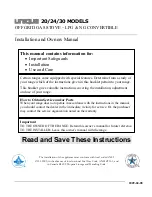
12
A newly-built chimney must conform to local codes and in their absence must recognize national
regulations. When using an existing chimney, it must be inspected by a licensed professional
chimney sweep, fire official, or code officer, to ensure that the chimney is in proper working order.
No other appliance can be vented into the same flue.
An airtight clean-out door should be located at the base of the chimney.
Prefabricated Chimneys
If a prefabricated metal chimney is to be used it must be a chimney type that is tested and listed
for use with solid fuel burning appliances. That means a chimney that is tested to the High Tem-
perature Standard ULC S-629 for Canada.
The manufacturer’s installation instructions must be followed precisely. Always maintain the
proper clearance to combustibles as established by the pipe manufacturer. This clearance is usu-
ally a minimum of 2” (56mm), although it may vary by manufacturer or for certain chimney compo-
nents.
Chimney Height
Whether a masonry chimney or prefabricated metal chimney is used it must be the required
height above the roof line.
The requirement is:
The chimney must be at least 3 feet higher than the highest point where it passes through the
roof and at least 2 feet higher than the highest part of the roof or structure that is within 10 feet of
the chimney, measured horizontally.
Chimneys shorter than 20 feet may not provide adequate draft. This could result in smoke spilling
into the room from the stove when loading the stove, or when the door is open. In addition, inade-
quate draft can cause back puffing, which is a build up of gases inside the firebox.
Other times, chimney height can create excessive draft which can cause high stove temperatures
and short burn times. Excessive drafts can be corrected by installing a butterfly damper. If you
suspect you have a draft problem, consult a wood-burning specialist. We recommend wood-
burning specialists who are certified by Wood Energy Technical Training (WETT).
Wall Pass-Throughs
When your installation unavoidably requires the chimney connector to pass through a combusti-
ble wall to reach the chimney, always consult your local building officials, and be sure any materi-
als to be used have been tested and listed for wall pass-throughs. In Canada, the standard has
been established by the Canadian Standard Association. The installation must conform to CAN/
CSA-B365, Installation Code for Solid Fuel Burning Appliances and Equipment. Before proceed-
ing be sure to consult your local building inspector.
Common Method:
This method requires the removal of all combustible materials from at least 18” (457mm) around
the chimney connector’s proposed location.
Содержание SEDORE
Страница 30: ...30 Domestic Hot Water Schematic Radiant Heater Schematic...
Страница 31: ...31 Parts Diagram...













































